 Jobsite cameras have become an essential tool for the modern connected jobsite. Understanding these systems and how they support construction best practices is important in today’s ever-expanding jobsite technology array. In this article, we’ll take a look at the evolution of jobsite cameras and how they are impacting the construction industry.
Jobsite cameras have become an essential tool for the modern connected jobsite. Understanding these systems and how they support construction best practices is important in today’s ever-expanding jobsite technology array. In this article, we’ll take a look at the evolution of jobsite cameras and how they are impacting the construction industry.
What Is a ‘Jobsite Camera’?
A jobsite camera is simply a camera that is used on a construction site to provide automated capture of imagery and/or video. Most would also agree that a jobsite camera is one that is network connected to allow for remote viewing and image retrieval. However, there are some more basic devices used on jobsites that record images and video to local storage for periodic manual retrieval by the user. For the purposes of our discussion here we will consider only network-connected cameras, since non-connected cameras are typically not suitable for commercial construction project applications.
In addition to the camera hardware itself, a "jobsite camera" typically also incorporates software that provides the following basic functions (at minimum):
- Remote configuration of the camera operation
- Viewing of images and video
- Remote long-term storage of images and video (e.g., cloud-based storage)
- Creation of time-lapse videos from individual still images collected at specified intervals
Back in the Day
The initial jobsite cameras grew out of early webcam applications. A webcam is a camera that is connected to the internet (or the web), to allow for remote real-time viewing. The first known webcam was at the University of Cambridge, England and was first connected to the web November 22, 1993. Webcams have since been adapted to a wide variety of applications that we are all familiar with, including video conferencing, traffic cameras, surveillance and more. One of the applications they were tailored to is construction monitoring.
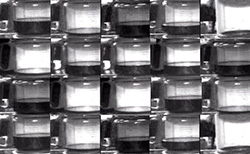
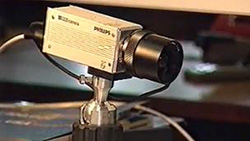
Images from BBC World Service Technology article, "How the world’s first webcam made a coffee pot famous," by Rebecca Kesby, published Nov. 22, 2012.
These early construction webcams had only basic capabilities due to technological limitations in internet connection speeds, digital camera hardware and limited software applications. These cameras produced only still images at lower frequencies and lower resolutions.
Even with these limitations, the concept proved attractive to the construction industry as a way to create time-lapse sequences of a projects progress, primarily for marketing purposes.
How Cameras are Used on Jobsites Today
Technology has clearly progressed tremendously since 1993, allowing today’s jobsite cameras to provide a much richer set of capabilities and to, therefore, support a much broader set of applications for construction companies.
Construction teams have also developed a greater understanding of how they can take advantage of jobsite camera technology to improve productivity, quality and safety on their jobsites. As often happens with new technologies, it starts being used in more and more ways, as users experiment and gain familiarity with the capabilities. Adopters start to look for ways to leverage the technology to solve for their challenges.
Today, jobsite cameras are used to address three key areas: productivity and project execution, risk and safety (including site security), and winning new projects. Let’s look at each of these areas in turn.
Productivity & Project Execution Use Cases
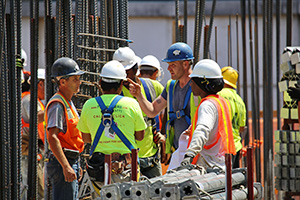 Productivity in construction execution is a broad category. Jobsite cameras are used to impact productivity in a variety of ways. Reducing travel time and costs by being able to monitor a site in real time from anywhere for example. Imagery collected from jobsite cameras can also make project coordination meetings more effective by having detailed as-built photos to review and compare to plans. By enabling project teams to see detailed visual documentation of as-built minute-by-minute progress, problems can be caught earlier, avoiding schedule delays and cost overruns.
Productivity in construction execution is a broad category. Jobsite cameras are used to impact productivity in a variety of ways. Reducing travel time and costs by being able to monitor a site in real time from anywhere for example. Imagery collected from jobsite cameras can also make project coordination meetings more effective by having detailed as-built photos to review and compare to plans. By enabling project teams to see detailed visual documentation of as-built minute-by-minute progress, problems can be caught earlier, avoiding schedule delays and cost overruns.
Analyzing the flow of workers and materials on a site can allow project teams to identify improvements that can impact time or labor requirements on a site. Providing the entire project team with access to real-time imagery also help teams stay coordinated and on the same page with minimal effort.
Risk, Safety and Site Security Use Cases
Jobsite cameras contribute to risk-management objectives and improving site safety in several ways. Today’s cameras can record video of the jobsite continuously. When a near miss or safety incident occurs, project teams can “review the tape” to determine the root cause and corrective actions to limit the risk going forward.
Monitoring compliance with the company’s quality assurance processes is simplified by having detailed image and video documentation of each step of the project. This same as-built visual documentation can be invaluable in dispute resolution, often helping avoid the high costs and delays associated with a lawsuit. Modern jobsite cameras also provide automated capture of jobsite weather information throughout the life of the build. This documented weather data can also help resolve disputes with subcontractors and owners.
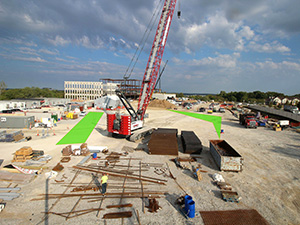 Some jobsite cameras can work double duty as a "security camera," providing automated monitoring for trespassing after hours. This can reduce safety liabilities for the general contractor. They can also provide a deterrent to reduce theft of tools, equipment and materials from the site.
Some jobsite cameras can work double duty as a "security camera," providing automated monitoring for trespassing after hours. This can reduce safety liabilities for the general contractor. They can also provide a deterrent to reduce theft of tools, equipment and materials from the site.
Jobsite cameras can also be combined with advanced video analytics to automatically detect events and situations on the jobsite. For example, detecting workers without proper PPE, or workers entering restricted areas, allows the GC to better enforce safety policies, and thus reduce risk.
Winning New Projects
Jobsite cameras help GCs continue to win business in multiple ways. Jobsite cameras allow owners to monitor projects in real-time, seeing the progress step-by-step. This transparency builds trust between the owner and the GC and can help win follow-on business. Showcasing strong build and quality processes can also attract the best owners. GCs can market their prior project experience by type and location using rich imagery.

Requirements for Cameras to Meet Todays Jobsite Needs
To deliver this large and growing set of applications for jobsite cameras in construction today, cameras must meet a broad set of technical requirements. Fortunately, the technology underlying jobsite cameras continues to improve creating even more potential.
What is Jobsite Camera Technology?
The first thing to understand is that what we call a "jobsite camera" is really a complex multi-function system that includes several basic and optional components.
- Digital Camera(s) – captures images/video digitally. Cameras typically vary in image and video resolution capabilities, and an ability to see in dark or low-light conditions.
- Processor – embedded computer/electronics that transfers images/video onto network. The processor is also responsible for processing the video/images, for example with video compression, to transport over the network. It may also host other functions such as video analytics to detect intrusions or count people on the jobsite.
- Network Interface – this connects the "camera" system to a network. This may take the form of Ethernet (hard-wired network) or a wireless network such as wifi or cellular.
- Local storage – this is local "edge-based" data storage that allows images/video to be stored locally on the camera, instead of, or prior to, transmission to the Cloud, over the network.
- Pan-Tilt-Zoom – an electro-mechanical capability to move the cameras aim both horizontally and vertically, and to zoom in and out, optically.
- Power System – the camera system must be powered. Some jobsite cameras include solar/battery operation. The power system consists of a rechargeable battery system, solar charge electronics and monitoring functions to report on system health.
Modular vs. Integrated Camera
There are some important differences in the types of jobsite cameras available on the market. One category can be viewed as "modular" vs. "integrated" in design. Modular jobsite cameras are made from standard components, like cellular routers and consumer cameras that are put into an enclosure. They may also include external power systems for solar or AC power.
Integrated camera designs are purpose-built as remote camera systems and include all components: camera(s), network/modem, storage, CPU and power system in a single integrated design. The integrated approach provides advantages in cost and reliability.
Breadth of Features
Another dimension of differences in jobsite cameras centers around breadth of features. To meet the full range of jobsite camera applications being used today, jobsite cameras must include the following capabilities:
- Live video streaming at various resolutions
- Capture of high-resolution still images for permanent as-built visual documentation
- Capture of rapid-still images down to 1-minute intervals to provide situational awareness
- Continuous recording of video to capture safety and site security incidents
- Video analytics for intrusion detection and other jobsite event detection (e.g., people counting, PPE compliance, restricted area breach alerts)
Solar & Wireless
Construction jobsites are not like other locations where cameras are used. They are highly dynamic and typically do not have readily available power or network connections. Running wires that will only be dug up, built over or tangled in a crane or other heavy equipment is not an option. Many jobsite cameras offer options for solar power with battery backup. The latest "compact-solar" systems provide 100 percent solar/battery operation in a package that is less than 10 lbs. and can be mounted anywhere easily. Compact solar offers several important practical advantages for deploying jobsite cameras:
-
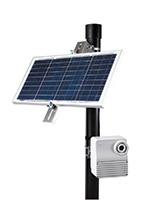 No delays or costs for running power
No delays or costs for running power - Allows for the selection of camera location based on best viewing, not power availability
- Allows for having more viewpoints on the project, ensuring 100 percent visual coverage
- Allows for easy relocation of cameras during project progresses
- No IT expert or electrician needed to install or setup cameras
- Easily redeployed to next project
It’s the Software!
The software provided with jobsite cameras is key to their overall ease-of-use and functionality. In addition to supporting the core "camera" features, Cloud-based software for jobsite cameras should provide the following capabilities to meet today’s requirements:
- Integrate with enterprise project management software to simplify workflow
- Integrate with alarm monitoring software to provide security services
- Features for public and team sharing of camera viewing/access
- Multiple user accounts with individual permission levels for sharing across the team
- Fully automated, instant and customized time-lapse movie generation
- Allow one dashboard to monitor many projects/cameras
- Image comparison and markup to support spotting problems early
- Integrate mobile app image capture
-
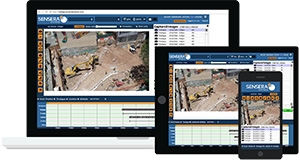 Integrate drone photography capture
Integrate drone photography capture - Image tagging to help organize as-built documentation and issue communication
- Accessible from mobile and desktop devices
- Allow easy search by date, tag or image type
- Automatically log and alert on system health
- Allow export of archived imagery
- Collect real-time weather information and time-stamp and archive
- Support simple configuration of cameras
- Automatic visual documentation organization
Security Cameras
Some of today’s jobsite cameras also act as security cameras, providing real-time intrusion detection, alerting and night vision. However, most traditional "security cameras" are not well suited for jobsite deployment. They are typically harder to install and require power and network availability at the camera location. Traditional security cameras are also typically designed to continuously stream video to a network server or storage. This architecture does not work well for jobsites that are typically connected via cellular since it incurs very high cellular data costs. Traditional security cameras also require video management software (VMS) which must be installed, hosted and paid for separately from the cameras.
What the Future Holds
 It’s a safe bet that the core technologies that make jobsite cameras possible will continue to evolve. Let’s look at some specific developments that are likely to occur and have a big impact on jobsite camera usage and capabilities.
It’s a safe bet that the core technologies that make jobsite cameras possible will continue to evolve. Let’s look at some specific developments that are likely to occur and have a big impact on jobsite camera usage and capabilities.
Integrated Electronics – Microelectronics will continue its march along the Moore’s law curve making jobsite cameras more compact, affordable and capable.
CMOS Camera Technology – CMOS digital camera technology has helped bring lower cost, more compact and higher-quality digital imaging to a broad range of markets. This will continue to help expand the use of jobsite cameras.
Video Analytics and AI – Improvements in computer vision and AI will allow jobsite cameras to turn images into information and to provide real-time detection of events and things of interest on the jobsite. Counting and tracking workers on a jobsite to better assess productivity and risk will become commonplace. There will be a growing list of "smarts" gained by jobsite cameras to continue to improve productivity and safety using video analytics and AI combined with jobsite cameras.
4D BIM – 3D BIM models combined with schedule (4D BIM) are already combining with jobsite cameras to automate the assessment of progress and to facilitate spotting problems sooner. Imagery from jobsite cameras are turned into 3D point-clouds and mapped to the 3D design model. This is then compared to the "4D" schedule information to determine status of the project. For example, if the 4D model called for facade to be installed by a specified date, and the imagery show it is incomplete, that can be flagged automatically, saving the project team detailed review time.
5G – Many (most) jobsite cameras employ cellular connections to provide remote viewing and image transfer. Today’s 4G/LTE systems provide quite good capabilities for live streaming. 5G technology promises to improve this further, making it feasible to stream extremely detailed video and super high-resolution imagery. It may also lower overall cellular data costs, enabling wider deployment of cellular-connected applications.
Integration with Other Jobsite Applications – Jobsite cameras can be combined with other jobsite applications such as asset tracking or worker wearables. This development will enable entirely new use-cases and capabilities and will simplify deploying these applications on jobsites. Jobsite camera software is already integrated with mobile apps for ground image capture, and with drone photography, to fully streamline jobsite reality capture.
Integration of indoor/360 photo documentation with outdoor image capture will allow a seamless and complete visual documentation capability. The growing ability to "geo-register" imagery will allow software to create a virtual "street view" type of documentation of the jobsite.
Evolving Use Cases
As contractors gain more experience with jobsite cameras and other real-time monitoring technologies, new use cases will likely emerge. As jobsite cameras become lower cost and easier to deploy, we will see them used more ubiquitously across the jobsite to provide more detail and coverage across the entire site.
Today’s Leading Jobsite Camera Makers
There are a variety of good jobsite camera options available on the market today. These offers vary in capability and price, providing buyers with a range of choices. Options like Sensera’s compact-solar cameras provide an unprecedented range of functionality and ease-of-use for ubiquitous camera coverage. Sensera’s SiteCloud software integrates mobile apps and drone photography with jobsite cameras to provide seamless visual documentation.
Advanced applications, such as automatically combining jobsite imagery with 4D BIM models to understand progress are already being deployed on real projects.
Leading GCs are making jobsite cameras standard "kit" for every project to ensure they are fully leveraging technology to improve construction outcomes.
Sensera Systems (www.senserasystems.com) has over 1000 general contractors using its next-generation jobsite cameras for productivity, quality assurance, safety, site security and more.
Earthcam (earthcam.net) is an earlier pioneer in traditional wired jobsite cameras for marketing.
OxBlue (oxblue.com) makes powered jobsite cameras for marketing and documentation of large construction projects.


Post a comment to this article
Report Abusive Comment